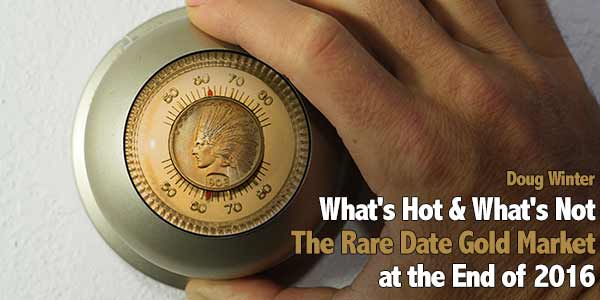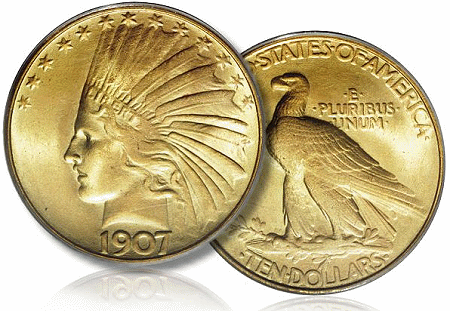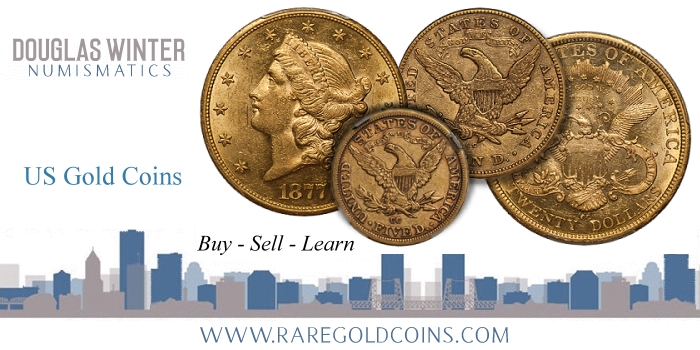
By Doug Winter – RareGoldcoins.com
CoinWeek Content Partner ……
From a numismatic point of view, 2016 wasn’t an especially good year. In most series, prices were down; in some cases by as much as 20-30%. Perhaps the only bright spot in the 2016 coin market was rare date gold. My business was strong in 2016 and I noticed a number of new collectors buying in areas as diverse as gold dollars to double eagles.
* * *
What was hot in the 2016 dated gold market and what wasn’t? I’m not sure I could call any area truly “hot” but there were some areas which saw considerable demand and in which I noticed new buyers.
What was strongest in 2016? Here are five areas.
1. Collector Grade Carson City Gold Coinage
I was a major player in the Carson City gold market until around 2010 but hadn’t participated much in the ensuing six years. I got back into the CC gold market this year due to having purchased a few deals; especially collector grade half eagles and eagles (“collector grade” in this case being VG to VF). I was surprised at how well these coins sold and how inaccurate current price guides are. Clearly, there is a strong market for nice, problem-free better date gold coins in the US$2,000-10,000 range.
If I had to rank the three denominations of collector quality CC gold in order of popularity, I’d say eagles, followed by double eagles with half eagles bringing up the rear. This may seem surprising as double eagles are intuitively more popular than eagles EXCEPT for the fact that CC double eagles are seldom seen in grades below VF-EF…
2. New Orleans Half Eagles and Eagles
I probably started more sets of these two denominations for collectors in 2016 than for any other mint. I think I know why: these sets are completable as there are no six-figure rarities, and they come with a tremendous back story.
New Orleans half eagles are a reasonably easy set to complete although a number of the No Motto issues are very hard to locate in grades above EF45 to AU50. For many new collectors, they have replaced Charlotte and Dahlonega half eagles as the “go to” larger-sized southern gold coin.
New Orleans eagles are another story. The No Motto issues are really hard to find in higher grade, especially if a collector is fussy. The With Motto eagles are for the most part easier although two dates (1879-O and 1883-O) are pricey and conditionally challenging.
Price levels for New Orleans half eagles and eagles didn’t really jump much in 2016 (except for finest known and Condition Census examples) but I noticed a definite surge in demand.
3. Nearly Any Coin With A Good Story
httpvh://youtu.be/yQdcBlNhgBQ
Gold coins are expensive. For a collector to pay $10,000 or $20,000 for a coin in 2016 it had to have a compelling story. This story can have many chapters: first-year-of-issue, one-year type, great pedigree, beautiful design, etc. But for a coin to sell in 2016 there has to be a compelling back story.
That’s why certain coins in my inventory sold quickly and easily in 2016. Coins like 1861-D dollars and half eagles. Or 1838-C and 1838-D half eagles. Or 1795 eagles and 1795 half eagles.
This is a trend I see continuing for both type coins and key date series coins.
4. $1,000-5,000 “Interesting” Coins
In a weaker coin market, the price points that seem to be least impacted are less expensive; a range that is collector-dominated and doesn’t represent the type of expenditure that produces checkbook anguish.
I always pay careful attention to what sells quickly off my website and what takes longer. If a coin is, say, $2,500 and fits the interesting/good eye appeal/PCGS-graded/CAC-approved parameters, then it tends to be a slam dunk to be gone within 24-48 hours.
The problem here is that while there are tons of interesting silver coins in the $1,000-5,000 range, the number of interesting gold coins in this range are considerably less numerous.
What denomination contains the greatest number of interesting $1,000-5,000 issues? I’d have to give that prize to quarter eagles; more specifically Philadelphia and San Francisco Liberty Head dates struck between 1840 and 1890. Not coincidentally, I noticed a good deal of activity in this area during 2016.
5. Dahlonega Gold
Dahlonega gold appears to have reached a tipping point where the supply of nice quality pieces is permanently lower than the demand. If you were a collector of high-grade Dahlonega pieces in 2016, you didn’t have an active buying year as there was an alarmingly small supply of suitable pieces.
What I find interesting about this specific market is that D-mint gold collectors (for the most part) appear to be longer-term holders than in other markets. Back in the 1990s and early 2000s, Dahlonega collections were formed and dispersed during a five-year-or-less time frame. Today, most Dahlonega collections are on a much longer clock.
Prices for Dahlonega coins increased in 2016, especially for choice, original pieces in PCGS holders with CAC approval. If I had to say how much, I’d guesstimate 5-10% or maybe even a bit more.
What was weakest in 2016? Here are four areas.
1. Generic Gold
Generic gold has been weak for years but 2016 was an extremely soft year for this market. The reason for this softness is obvious: a huge supply with a shriveling demand.
When there are marketing firms selling generics, demand is created. But few of these firms are focused on generics in 2016, for a variety of reasons. Until demand is somehow sparked, I see levels go even lower.
MS64 Liberty Head quarter eagles at less than $500 and MS64 Liberty Head half eagles at less than $600. Can they get any cheaper? I’m afraid that they can and will (*shudder*).
2. Common Date Type One Double Eagles

While many Type 1 Liberty Head Double Eagles were weak in 2016, rare issues held their own.
This area of the market was weak in 2016 for two reasons: an oversupply due to a few hoards becoming available and profit-taking in 2014 and 2015 by collectors who smartly saw prices at unsustainable levels.
Let me categorically state that the entire Type One market is NOT weak. Rare dates, particularly O-mints, are still strong in demand. The dates that I feel are weak include the 1850-1853 P-mint issues and the 1856 to 1865 S mint issues in EF and AU grades, especially if they are not original and if they are not CAC-approved.
3. Ugly Coins
Unless a coin is really, really rare it has to be aesthetically pleasing in this day and age. Many collectors make their coin purchases based on images, and if the coin doesn’t image well then it doesn’t sell. That’s why I find myself looking at potential new purchases from a photo-worthy perspective: will they image nicely or not?
What makes a specific coin “ugly?” It can be any number of factors: cleaning(s); dark, unattractive coloration; poorly situated marks and/or an overabundance of abrasions – or a combination of these.
What about a really rare coin which is almost never seen with positive eye appeal, like an 1864-S half eagle? I would buy an “average” looking 1864-S but would pass on one that was really ugly. This is an expensive coin, and who really wants a dodgy-looking $50,000 half eagle in their collection?
4. Indian Head Gold
 The market for Indian Head quarter eagles, half eagles and eagles is complicated and it is multiply bifurcated (yes, I just made this expression up but I can prove it makes sense).
The market for Indian Head quarter eagles, half eagles and eagles is complicated and it is multiply bifurcated (yes, I just made this expression up but I can prove it makes sense).
All three of these denominations have three distinct types of coins: common dates (which are essentially generics; examples would be a 1925-D quarter eagle and a 1926 eagle), semi-key dates (examples include a 1912-S half eagle and a 1915-S eagle) and rarities (a 1920-S eagle). In 2016, the first two categories were weak while the third was strong(er).
But wait, now it gets confusing.
Some semi-key dates (such as the aforementioned 1912-S half eagle) are condition rarities, meaning that while they are ho-hum in AU55, they are rare and valuable in MS65. And there are essentially four flavors of Indian Head gold: PCGS, PCGS with CAC, NGC and NGC with CAC. Our 1912-S might be cold as ice in a straight NGC holder but in strong demand if graded by PCGS and approved by CAC.
The bottom line was that most Indian Head gold was weak in 2016 but certain pieces (PCGS and CAC) were very strong.
These are my personal observations for what was hot in 2016 and what was not. I’d love to get your take and invite you to comment in the section below.

* * *
About Doug Winter
 Doug has spent much of his life in the field of numismatics; beginning collecting coins at the age of seven, and by the time he was 10 years old, buying and selling coins at conventions in the New York City area.
Doug has spent much of his life in the field of numismatics; beginning collecting coins at the age of seven, and by the time he was 10 years old, buying and selling coins at conventions in the New York City area.
In 1989, he founded Douglas Winter Numismatics, and his firm specializes in buying and selling choice and rare United States coins, especially US gold coins and all branch mint material.
Recognized as one of the leading specialized numismatic firms, Doug is an award winning author of over a dozen numismatic books and the recognized expert on US Gold. His knowledge and exceptional eye for properly graded and original coins has made him one of the most respected figures in the numismatic community and a sought after dealer by collectors and investors looking for professional personalized service, a select inventory of impeccable quality and fair and honest pricing. Doug is also a major buyer of all US coins and is always looking to purchase collections both large and small. He can be reached at 214-675-9897.
Doug has been a contributor to the Guidebook of United States Coins (also known as the “Redbook”) since 1983, Walter Breen’s Encyclopedia of United States and Colonial Coins, Q. David Bowers’ Encyclopedia of United States Silver Dollars and Andrew Pollock’s United States Pattern and Related Issues
In addition he has authored 13 books on US Gold coins including:
- Gold Coins of the New Orleans Mint: 1839-1909
- Gold Coins of the Carson City Mint: 1870 – 1893
- Gold Coins of the Charlotte Mint: 1838-1861
- Gold Coins of the Dahlonega Mint 1838-1861
- The United States $3 Gold Pieces 1854-1889
- Carson City Gold Coinage 1870-1893: A Rarity and Condition Census Update
- An Insider’s Guide to Collecting Type One Double Eagles
- The Connoisseur’s Guide to United States Gold Coins
- A Collector’s Guide To Indian Head Quarter Eagles
- The Acadiana Collection of New Orleans Coinage
- Type Three Double Eagles, 1877-1907: A Numismatic History and Analysis
- Gold Coins of the Dahlonega Mint, 1838-1861: A Numismatic History and Analysis
- Type Two Double Eagles, 1866-1876: A Numismatic History and Analysis
Finally Doug is a member of virtually every major numismatic organization, professional trade group and major coin association in the US.




